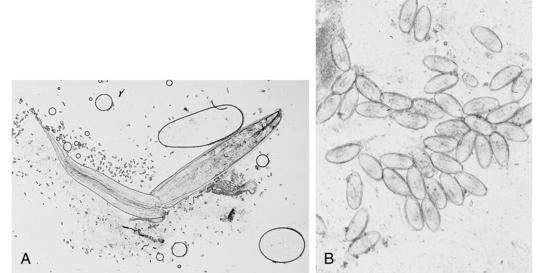CHAPTER 34 Vaginal discharge and itching
Diagnostic reasoning: focused history
Characteristics of discharge
Copious amounts of greenish, offensive-smelling discharge are most consistent with T. vaginalis. Mucopurulent or purulent discharges are associated with gonorrhea and Chlamydia. A moderate amount of white, curd-like discharge is consistent with Candida vulvovaginitis. BV typically produces a discharge that is thin and either white, green, gray, or brownish. Although characteristic symptoms associated with each type of vaginal discharge can be helpful in arriving at a diagnosis, they are not diagnostic in and of themselves. Microscopic examination of the vaginal discharge is more sensitive than the clinical picture in confirming the diagnosis (Figure 34-1).
Odor
A fishy odor caused by the release of amines from organic acids is prominent with BV. It is accentuated by the addition of potassium hydroxide (KOH) to the wet mount slide and is considered a positive “whiff” test. Odor commonly accompanies trichomonal infections. Retained tampons or other foreign bodies can also cause a foul odor.
Is this likely a sexually transmitted infection?
Key questions
 Are you sexually active? Do you have multiple partners? Do you have a new partner?
Are you sexually active? Do you have multiple partners? Do you have a new partner?
 Have you had sex against your will? If a child: You might ask, “Has anyone touched your private parts?”
Have you had sex against your will? If a child: You might ask, “Has anyone touched your private parts?”
 What form of protection do you use? How often do you use protection?
What form of protection do you use? How often do you use protection?
 Have you or your partner(s) ever been tested or treated for a sexually transmitted infection (STI)?
Have you or your partner(s) ever been tested or treated for a sexually transmitted infection (STI)?
 Do you have any rashes, blisters, sores, lumps, or bumps in the genital area?
Do you have any rashes, blisters, sores, lumps, or bumps in the genital area?
Lesions
Can this be vaginitis that is not related to an sti?
Key questions
 Have you ever been told that you have diabetes or Cushing syndrome or that you are positive for HIV infection?
Have you ever been told that you have diabetes or Cushing syndrome or that you are positive for HIV infection?
 Are you taking antibiotics, hormones, or oral contraceptive pills?
Are you taking antibiotics, hormones, or oral contraceptive pills?
 Have you received chemotherapy?
Have you received chemotherapy?
 Does the itching seem to be worse at night?
Does the itching seem to be worse at night?
 Can you describe some of your recent activities?
Can you describe some of your recent activities?
Immunocompromised states
Refractory fungal vulvovaginitis may indicate undiagnosed diabetes or an immunocompromised state.
Night itching
Pinworms are intestinal parasites that inhabit the rectum or colon and emerge to lay eggs in the skinfolds of the anus. Perianal pruritus, especially at night, along with pain or itching of genitals is common (Figure 34-2).
Chronology of symptoms
The occurrence of vaginal discharge after having a new sex partner suggests an acute condition, such as a sexually transmitted infection. Symptoms associated with use of condoms or spermicidal jelly suggest sensitivity to the product. If the discharge occurs monthly, becoming worse after menses, suspect a chronic condition, such as vulvovaginitis candidiasis. Recurrent episodes related to bathing activities point to chemical irritation.
Adequate treatment
If this is chronic, what should i suspect?
New or untreated partner
The most common cause of reinfection is intercourse with a new or untreated partner.
Stay updated, free articles. Join our Telegram channel

Full access? Get Clinical Tree























